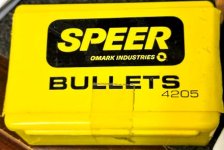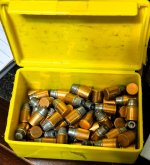A great friend recently gifted to me a few rounds of what we both believe to be REALLY old .357 Magnum ammo.
Nickel plated brass case with the head stamp that says exactly:
W. R. A. S&W .357 Magnum
…and the humdinger, a large primer, not a small primer.
Research has not been too easy as it seems my skill with web searching is limited. I have taken the time and I don’t mind spending my time reading or researching but the problem has been that all the search terms I try don’t give me historical results, most of my results are all more geared to handloading or chasing down new or used brass.
What I would like is to get a better idea of when the ammo companies made the switch to small primer as the standard for the .357 Magnum. The few results that seem hopeful have suggested that this change to small primer may have happened in 1939.
Do we have any serious cartridge collectors active here that can throw some facts and history at me, or point me in a direction that helps?
These bullets look interesting and “not of recent times” either, it almost appears to be a half-jacket design where the entirety of the gilding metal is inside the cartridge case and the outer projectile looks almost like a lead semiwadcutter, although perhaps a little more slender and maybe slightly more of a point.
Let me see if I can get a good picture.
Nickel plated brass case with the head stamp that says exactly:
W. R. A. S&W .357 Magnum
…and the humdinger, a large primer, not a small primer.
Research has not been too easy as it seems my skill with web searching is limited. I have taken the time and I don’t mind spending my time reading or researching but the problem has been that all the search terms I try don’t give me historical results, most of my results are all more geared to handloading or chasing down new or used brass.
What I would like is to get a better idea of when the ammo companies made the switch to small primer as the standard for the .357 Magnum. The few results that seem hopeful have suggested that this change to small primer may have happened in 1939.
Do we have any serious cartridge collectors active here that can throw some facts and history at me, or point me in a direction that helps?
These bullets look interesting and “not of recent times” either, it almost appears to be a half-jacket design where the entirety of the gilding metal is inside the cartridge case and the outer projectile looks almost like a lead semiwadcutter, although perhaps a little more slender and maybe slightly more of a point.
Let me see if I can get a good picture.








